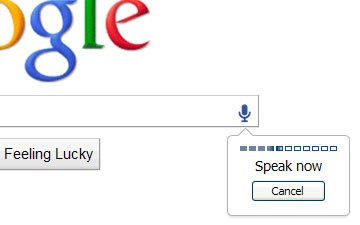Google has evolved over the years to become much more than a white page with a search box, but they haven’t abandoned finding new ways to innovate what got them started. The search giant recently unveiled a few new ways to search the Internet from the world’s number one website. The first new way, voice search, allows users to click a small microphone icon in the search box and say what it is they want to search. Google simply translates the audio into a searchable term and does a search as if you typed it. The second way allows users to upload a picture by dragging it into the browser. Google will then analyze the picture and bring up relevant information to what it is.
Voice search isn’t anything new, as Google made it available to mobile users in 2009 with an update to its Android mobile operating system. Nowadays, Android gives its mobile users many options for searching with their voice. Simple, preset commands followed by a subject will trigger your phone to start playing your favorite song, find directions, text someone, email someone, or many other things all from your voice. These commands have become a part of my everyday life while I’m trying to multitask, but I’m not convinced these same features will be as useful on a full-fledged web browser. Right now I can type an average of 75 words per minute. While this is a bit more than the average user, I would be confident in saying that most people can type reasonably fast. Typing a word or short phrase in a search box would probably take the average user four seconds, max. So what is Google trying to accomplish with voice search on desktops?
The only reason I can think of, beside just glamming search up, is to say a word you’re not quite sure how to spell. Many people have a hard time spelling long, complex words, so being able to say them instead of typing them will be great. But wait, Google has suggestions. When you start typing the first few letters of a word, chances are the word will show up in a drop-down list. Users won’t be getting any more help than they already receive. A much more practical use of voice search on a desktop is Google’s Voice Search Chrome extension. You’ll want to check out the top Chrome extensions for SAAS as well. This extension adds a button on your browser that, when pressed, you can say a term or phrase and a new tab will open with the results. This makes more sense. It will help those people who often have many tabs open and need to search something quick.
There is one more reason voice search could be useful, and that is for people who have a hard time typing due to age, disability, or any other reason. These people are important too and they need to be able to search the Internet just like every other person in the world. For that, Google, I say good job and thank you, but I can’t see this as much more than a gimmick for the average, everyday user.
Unlike desktop voice search, picture search is a little more understandable. This too has been around on Android for a while with the use of the Google Goggles application. With Google Goggles, a user takes a picture of something and Google does a search of the object based on what their analysis thinks it is. The desktop version works the same way. A user drags a picture onto the search bar and, after it gets automatically uploaded, Google provides search results on what they think it is. I tested this with a picture of a platypus, and sure enough the results thrown back at me were of a search for “duck-billed platypus.” I could see this being much more useful than the voice search option detailed above. For example, if you go on vacation and take pictures of several landmarks, you might not remember what each one is called. Uploading one of your pictures to Google search will quickly (and hopefully accurately) give you all the details you need. You could also go on a hike and take pictures of mysterious animals, and use Google to find out what they are. While Google Goggles might be the better option for instant feedback, many people still don’t have mobile phones with those capabilities.
While Google probably isn’t trying to change the world with either of these features, it is nice to see that they are adding fresh updates. I don’t foresee either one being a part of my everyday use, but I could be wrong. Perhaps this is the future of search, or just the beginning of a voice automated world that goes beyond mobile. What are your thoughts? Will you use voice and picture search in Google, or stick to old fashioned typing?


